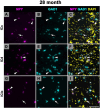Neuropeptide Y mRNA expression in the aging inferior colliculus of fischer brown norway rats
- PMID: 40771198
- PMCID: PMC12326481
- DOI: 10.3389/fnagi.2025.1626021
Neuropeptide Y mRNA expression in the aging inferior colliculus of fischer brown norway rats
Abstract
Introduction: A major contributor to age-related hearing loss is the decline of GABAergic inhibition, particularly in the inferior colliculus (IC), which is the midbrain hub of the central auditory system. The initial loss of inhibition is thought to be a compensatory mechanism in response to decreased peripheral excitation. However, the downregulation of inhibition in the IC persists with age and leads to functional disruptions and central neural gain. Neuropeptide Y (NPY) is co-expressed by a sub-population of GABAergic IC cells whose age-related changes remain unexplored. We sought to characterize GABAergic cells in the major subdivisions of the IC that express NPY mRNA to determine whether NPY mRNA is altered in aging IC cells.
Methods: We used multiplexed fluorescent in situ hybridization (smFISH) to label lemniscal and non-lemniscal IC cells that express NPY mRNA and/or GAD1 mRNA in four age groups of Fischer Brown Norway (FBN) rats.
Results: The data demonstrate that ∼38% of GABAergic IC cells co-express NPY, the largest proportion of NPY cells is in the non-lemniscal dorsal IC (ICd), the majority of NPY cells have medium profile areas, and the expression of individual NPY mRNA is unaffected by age.
Discussion: While GABAergic inhibition is reduced with age, it appears that NPY driven inhibition may remain intact. GABAergic neurons that co-express NPY may represent a marked population that persists throughout aging, suggesting that they are not the primary contributor to age-related loss of inhibition.
Keywords: GAD1 mRNA; NPY; NPY mRNA; aging; inferior colliculus; smFISH.
Copyright © 2025 Almassri, Crane, Hergenrother, Singh, Barach, Iafrate, Harris, Tokar, Ohl, Young and Mellott.
Conflict of interest statement
The authors declare that the research was conducted in the absence of any commercial or financial relationships that could be construed as a potential conflict of interest.
Figures












Similar articles
-
Lineage-tracing reveals an expanded population of NPY neurons in the inferior colliculus.J Neurophysiol. 2024 Aug 1;132(2):573-588. doi: 10.1152/jn.00131.2024. Epub 2024 Jul 11. J Neurophysiol. 2024. PMID: 38988288 Free PMC article.
-
Age-related differences in GABAergic synapses across the central inferior colliculus in the Fischer Brown Norway rat.Neurobiol Aging. 2025 Sep;153:30-48. doi: 10.1016/j.neurobiolaging.2025.06.002. Epub 2025 Jun 6. Neurobiol Aging. 2025. PMID: 40505595
-
Ototoxicity-related changes in GABA immunolabeling within the rat inferior colliculus.Hear Res. 2024 Oct;452:109106. doi: 10.1016/j.heares.2024.109106. Epub 2024 Aug 21. Hear Res. 2024. PMID: 39181061
-
The Black Book of Psychotropic Dosing and Monitoring.Psychopharmacol Bull. 2024 Jul 8;54(3):8-59. Psychopharmacol Bull. 2024. PMID: 38993656 Free PMC article. Review.
-
Clinical symptoms, signs and tests for identification of impending and current water-loss dehydration in older people.Cochrane Database Syst Rev. 2015 Apr 30;2015(4):CD009647. doi: 10.1002/14651858.CD009647.pub2. Cochrane Database Syst Rev. 2015. PMID: 25924806 Free PMC article.
References
Grants and funding
LinkOut - more resources
Full Text Sources
Miscellaneous

